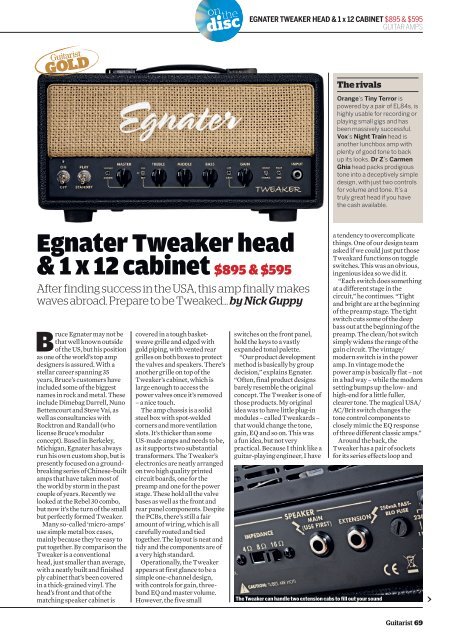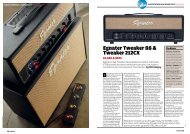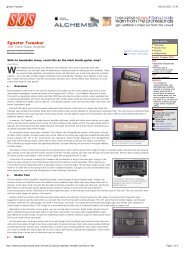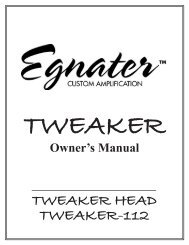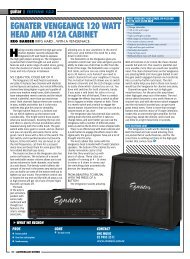Create successful ePaper yourself
Turn your PDF publications into a flip-book with our unique Google optimized e-Paper software.
����������������������<br />
����������������������������<br />
After finding success in the USA, this amp finally makes<br />
waves abroad. Prepare to be Tweaked… <strong>by</strong> <strong>Nick</strong> <strong>Guppy</strong><br />
�ruce <strong>Egnater</strong> may not be<br />
that well known outside<br />
of the US, but his position<br />
as one of the world’s top amp<br />
designers is assured. With a<br />
stellar career spanning 35<br />
years, Bruce’s customers have<br />
included some of the biggest<br />
names in rock and metal. These<br />
include Dimebag Darrell, Nuno<br />
Bettencourt and Steve Vai, as<br />
well as consultancies with<br />
Rocktron and Randall (who<br />
license Bruce’s modular<br />
concept). Based in Berkeley,<br />
Michigan, <strong>Egnater</strong> has always<br />
run his own custom shop, but is<br />
presently focused on a groundbreaking<br />
series of Chinese-built<br />
amps that have taken most of<br />
the world <strong>by</strong> storm in the past<br />
couple of years. Recently we<br />
looked at the Rebel 30 combo,<br />
but now it’s the turn of the small<br />
but perfectly formed Tweaker.<br />
Many so-called ‘micro-amps’<br />
use simple metal box cases,<br />
mainly because they’re easy to<br />
put together. By comparison the<br />
Tweaker is a conventional<br />
head, just smaller than average,<br />
with a neatly built and finished<br />
ply cabinet that’s been covered<br />
in a thick-grained vinyl. The<br />
head’s front and that of the<br />
matching speaker cabinet is<br />
covered in a tough basketweave<br />
grille and edged with<br />
gold piping, with vented rear<br />
grilles on both boxes to protect<br />
the valves and speakers. There’s<br />
another grille on top of the<br />
Tweaker’s cabinet, which is<br />
large enough to access the<br />
power valves once it’s removed<br />
– a nice touch.<br />
The amp chassis is a solid<br />
steel box with spot-welded<br />
corners and more ventilation<br />
slots. It’s thicker than some<br />
US-made amps and needs to be,<br />
as it supports two substantial<br />
transformers. The Tweaker’s<br />
electronics are neatly arranged<br />
on two high quality printed<br />
circuit boards, one for the<br />
preamp and one for the power<br />
stage. These hold all the valve<br />
bases as well as the front and<br />
rear panel components. Despite<br />
the PCBs, there’s still a fair<br />
amount of wiring, which is all<br />
carefully routed and tied<br />
together. The layout is neat and<br />
tidy and the components are of<br />
a very high standard.<br />
Operationally, the Tweaker<br />
appears at first glance to be a<br />
simple one-channel design,<br />
with controls for gain, threeband<br />
EQ and master volume.<br />
However, the five small<br />
�������������������������������������������������<br />
�����������<br />
switches on the front panel,<br />
hold the keys to a vastly<br />
expanded tonal palette.<br />
“Our product development<br />
method is basically <strong>by</strong> group<br />
decision,” explains <strong>Egnater</strong>.<br />
“Often, final product designs<br />
barely resemble the original<br />
concept. The Tweaker is one of<br />
those products. My original<br />
idea was to have little plug-in<br />
modules – called Tweakards –<br />
that would change the tone,<br />
gain, EQ and so on. This was<br />
a fun idea, but not very<br />
practical. Because I think like a<br />
guitar-playing engineer, I have<br />
The rivals<br />
������������������������<br />
�������������������������������<br />
�������������������������������<br />
���������������������������<br />
���������������������������<br />
��������������������������<br />
��������������������������<br />
����������������������������<br />
����������������������������<br />
���������������������������<br />
�������������������������������<br />
�������������������������������<br />
����������������������������<br />
�����������������������������<br />
�������������������<br />
a tendency to overcomplicate<br />
things. One of our design team<br />
asked if we could just put those<br />
Tweakard functions on toggle<br />
switches. This was an obvious,<br />
ingenious idea so we did it.<br />
“Each switch does something<br />
at a different stage in the<br />
circuit,” he continues. “Tight<br />
and bright are at the beginning<br />
of the preamp stage. The tight<br />
switch cuts some of the deep<br />
bass out at the beginning of the<br />
preamp. The clean/hot switch<br />
simply widens the range of the<br />
gain circuit. The vintage/<br />
modern switch is in the power<br />
amp. In vintage mode the<br />
power amp is basically flat – not<br />
in a bad way – while the modern<br />
setting bumps up the low- and<br />
high-end for a little fuller,<br />
clearer tone. The magical USA/<br />
AC/Brit switch changes the<br />
tone control components to<br />
closely mimic the EQ response<br />
of three different classic amps.”<br />
Around the back, the<br />
Tweaker has a pair of sockets<br />
for its series effects loop and<br />
����������������������������������������������������������������<br />
Guitarist�69


